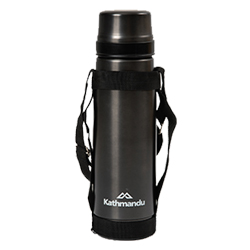
Which vacuum flasks work best?
We trialled eight flasks and found some kept their temperature better than others.

Need to keep your coffee hot over a long day on the farm or building site? Want an ice-cold drink at the summit of your hike?
Insulated or vacuum flasks are double-walled containers that use the same concept as double-glazed windows to regulate the temperature of your drink (or soup). You might associate them with the brand name Thermos.
We bought six litre-sized flasks from five brands and assessed how long they kept drinks above 50°C, which we deemed the lowest temperature you’d still call “hot”. Similarly, we checked how long cold drinks stayed below 17°C. We used two different ambient (room) temperatures – a wintry 5°C for the hot test and a toasty 22°C for both hot and cold. Finally, we dropped each flask a few times to see if any damaged easily.
Key results
- At 5°C, all of the flasks kept drinks hot for at least six hours. Half of them lasted for 24 hours.
- At the 22°C room temperature, all but one of the flasks stayed hot for at least 16 hours.
- All flasks were as good or better for cold drinks compared to hot drinks. All but one remained cool for at least a full day.
- The steel flasks only suffered minor denting and cosmetic damage when dropped onto concrete. The plastic flask was worse off.
If you only want same-day insulation and don’t need your beverage piping hot or ice cold, there’s nothing wrong with a cheaper flask. However, there are advantages to spending big, such as robust carry handles.
Which flask suits you best?

CamelBak Chute Mag Vacuum $75
Resembling a stylish drink bottle more than a traditional flask, the Chute Mag has a single lid with a unique magnetic cap for easy access. The cap is sturdy and well-engineered, providing an even pour. However, convenience and looks come at the expense of thermal performance. The CamelBak was by far the poorest insulator in the test – you can feel its lid warm up when it’s filled hot, which means heat is escaping.
Ideal for: short trips where you’ll be drinking often.

Kathmandu Vacuum Harness Flask $65
With a black stainless-steel finish, Kathmandu’s insulated flask is one of the most beautiful out there (though it might get hot in the sun). The harness will be useful for some, although you’ll need a clip or carabiner to attach it to anything – alternatively, the harness can be easily removed. The inner stopper opens smoothly and has a handy toggle that lets you pour without removing it. It also passed the durability test with flying colours.
Ideal for: tramping – it’s relatively light and can strap to your backpack.

Living & Co Slimline $15
Despite being a cheaper option, this flask from The Warehouse looks good and works pretty well. It has a nice inner stopper, with a super-smooth screwing action and the same easy-pour toggle as the Kathmandu flask. The flow through the stopper is good, as long as you don’t try to pour too quickly. Its biggest flaw is that liquid can get stuck in the stopper after use, which is concerning if it’s something that could grow mould, such as soup.
Ideal for: bargain-hunters, children and those who don’t need a flask often.

Stanley Classic Flask $80
With its military-green finish, Stanley’s flask is presented as the premium option for rugged pursuits, such as hunting. It’s reasonably heavy, but its excellent handle makes carrying easier without adding much bulk. It has bolder claims than its competitors, stating it can keep drinks hot for more than a day – and they generally stack up. However, we couldn’t replicate the claim it keeps “iced” drinks cold for six days – our drink came out at 19°, just below the 22° room temperature.
Ideal for: rough treatment – it’s more suited to sitting in a pile of mud than in a picnic basket.

Thermos Designer Flask $20
This is the most distinctive flask in our trial. It’s the only one not made from stainless steel, instead using a glass inner wall. It’s heavy and also bulky, suggesting more space between the walls. It comes with two cups, either of which can double as the lid. The stopper is hollow, which feels cheap, but it does provide a handy place to store your teabags. When dropped, the outside plastic broke in places while the glass seemed to stay intact – though we’d think twice before drinking from it afterwards.
Ideal for: people who trust the Thermos brand but don’t want to spend much.

Thermos Dura-Vac DV 100 $45
This is it, the timeless Thermos. It’s well-designed and it works. There’s a rudimentary handle that isn’t especially comfortable but takes up no extra space. It comes with an attachable strap to help you fasten it to your bag. It was incredibly resilient in the drop test. It’s just a trusty Thermos – but its lack of visual flair puts it at a surprisingly low price point.
Ideal for: anyone who wants a quality, sturdy flask at a good price.
A bigger flask means better performance
To find out if bigger is better when it comes to thermal performance, we compared the Stanley flask to its 700mL and 1.9L siblings.

The baby of the bunch is sold as a “food jar”, intended for soups and the like as well as drinks. It’s lighter and takes up less space, but we found that it didn’t keep temperature as effectively. The physics checks out – a smaller container has more exposed surface area per litre of liquid, so can be expected to revert to the ambient temperature at a faster rate.
The larger flask performed significantly better. Its two-day regulation of both hot and cold drinks was impressive but, like with the 1L flask, we couldn’t substantiate its frankly bizarre claim to keep iced drinks cold for eight days.
Member comments
Get access to comment